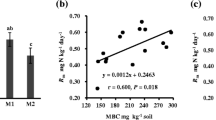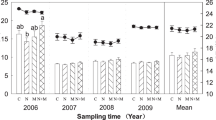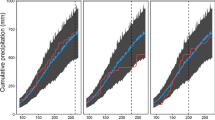Abstract
Purpose
The study aimed to explore how grazing and mowing influence the archaeal, bacterial, and fungal nitrous oxide (N2O) production potential and identify the key soil factors driving N2O emissions from soil.
Methods
Three treatments: fence (no grazing or mowing), grazing, and mowing were set in a field-scale experiment. Total (TNEA and TDEA), fungal (FNEA and FDEA), bacterial (BNEA and BDEA), and archaeal (ANEA and ADEA) nitrification and denitrification enzyme activities were measured to compare the effect of grazing and mowing on the potential of N2O emission.
Results
The TC varied from 16.7 to 19.0 g kg−1 and the TN content varied from 1.19 to 1.37 g kg−1 during the growing season. The TNEA, TDEA, BNEA, and BDEA were significantly higher in summer (July) (p < 0.01), and in grazing than other treatments (p = 0.01). Archaeal nitrification enzyme activity (ANEA) was significantly higher in July (p < 0.01), but showed no difference among control, grazing, and mowing. Fungal nitrification enzyme activity (FNEA) showed no difference among all treatments and seasons. Fungi made a greater contribution to TNEA and TDEA in all seasons except to TNEA in summer.
Conclusions
Short-term grazing increased soil N2O production potential through stimulating the bacterial nitrification and denitrification in summer which was the peak growth period of grassland. Mowing did not affect the N2O production potential in all seasons, suggesting that the effect of grazing on the soil nitrogen cycle operated by microorganisms is more disturbance than mowing in this Inner Mongolia grassland.





Similar content being viewed by others
References
Akiyama T, Kawamura K (2007) Grassland degradation in China: methods of monitoring, management and restoration. Grassl Sci 53:1–17. https://doi.org/10.1111/j.1744-697x.2007.00073.x
Bai YF, Wu JG, Clark CM, Naeem S, Pan QM, Huang JH, Zhang LX, Han XG (2010) Tradeoffs and thresholds in the effects of nitrogen addition on biodiversity and ecosystem functioning: evidence from inner Mongolia Grasslands. Glob Chang Biol 16:358–372. https://doi.org/10.1111/j.1365-2486.2009.01950.x
Bardgett RD, Wardle DA, Yeates GW (1998) Linking above-ground and below-ground interactions: how plant responses to foliar herbivory influence soil organisms. Soil Biol Biochem 30:1867–1878. https://doi.org/10.1016/S0038-0717(98)00069-8
Castaldi S, Smith KA (1998) Effect of cycloheximide on N2O and NO3- production in a forest and an agricultural soil. Biol Fertil Soils 27:27–34. https://doi.org/10.1007/s003740050395
Chamindu Deepagoda T, Jayarathne J et al (2019) Soil-gas diffusivity and soil-moisture effects on N2O emissions from intact pasture soils. Soil Sci Soc Am J 83:1032–1043. https://doi.org/10.2136/sssaj2018.10.0405
Chen H, Mothapo NV, Shi W (2015) Fungal and bacterial N2O production regulated by soil amendments of simple and complex substrates. Soil Biol Biochem 84:116–126. https://doi.org/10.1016/j.soilbio.2015.02.018
Chen W, Zheng XH, Wolf B et al (2019) Long-term grazing effects on soil-atmosphere exchanges of CO2, CH4, and N2O at different grasslands in Inner Mongolia: a soil core study. Ecol Indic 105:316–328. https://doi.org/10.1016/j.ecolind.2017.09.035
Chen YL, Hu HW, Han HY et al (2014) Abundance and community structure of ammonia-oxidizing archaea and bacteria in response to fertilization and mowing in a temperate steppe in Inner Mongolia. FEMS Microbiol Ecol 89:67–79. https://doi.org/10.1111/1574-6941.12336
Collins SL, Sinsabaugh RL, Crenshaw C et al (2008) Pulse dynamics and microbial processes in aridland ecosystems. J Ecol 96:413–420. https://doi.org/10.1111/j.1365-2745.2008.01362.x
Dassonville N, Guillaumaud N, Piola F et al (2011) Niche construction by the invasive Asian knotweeds (species complex Fallopia): impact on activity, abundance and community structure of denitrifiers and nitrifiers. Biol Invasions 13:1115–1133. https://doi.org/10.1007/s10530-011-9954-5
Di HJ, Cameron KC, Shen JP et al (2009) Nitrification driven by bacteria and not archaea in nitrogen-rich grassland soils. Nat Geosci 2:621–624. https://doi.org/10.1038/ngeo613
Gao YZ, Giese M, Lin S et al (2008) Belowground net primary productivity and biomass allocation of a grassland in Inner Mongolia is affected by grazing intensity. Plant Soil 307:41–50. https://doi.org/10.1007/s11104-008-9579-3
Han G, Hao X, Zhao M et al (2008) Effect of grazing intensity on carbon and nitrogen in soil and vegetation in a meadow steppe in Inner Mongolia. Agric Ecosyst Environ 125:21–32. https://doi.org/10.1016/j.agee.2007.11.009
Hayatsu M, Tago K, Saito M (2008) Various players in the nitrogen cycle: diversity and functions of the microorganisms involved in nitrification and denitrification. Soil Sci Plant Nutr 54:33–45. https://doi.org/10.1111/j.1747-0765.2007.00195.x
He N, Zhang Y, Dai J et al (2012) Land-use impact on soil carbon and nitrogen sequestration in typical steppe ecosystems, Inner Mongolia. J Geogr Sci 22:859–873. https://doi.org/10.1007/s11442-012-0968-4
Heil J, Liu S, Vereecken H et al (2015) Abiotic nitrous oxide production from hydroxylamine in soils and their dependence on soil properties. Soil Biol Biochem 84:107–115. https://doi.org/10.1016/j.soilbio.2015.02.022
Herold MB, Baggs EM, Daniell TJ (2012) Fungal and bacterial denitrification are differently affected by long-term pH amendment and cultivation of arable soil. Soil Biol Biochem 54:25–35. https://doi.org/10.1016/j.soilbio.2012.04.031
Houlbrooke DJ, Littlejohn RP, Morton JD et al (2008) Effect of irrigation and grazing animals on soil quality measurements in the North Otago Rolling Downlands of New Zealand. Soil Use Manag 24:416–423. https://doi.org/10.1111/j.1475-2743.2008.00183.x
Huang Y, Xiao X, Long X (2017) Fungal denitrification contributes significantly to N2O production in a highly acidic tea soil. J Soils Sediments 17:1599–1606. https://doi.org/10.1007/s11368-017-1655-y
IPCC (2013) Climate Change 2013: The Physical Science Basis. Contribution of Working Group I to the Fifth Assessment Report of the Intergovernmental Panel on Climate Change. Cambridge University Press, Cambridge (United Kingdom) and New York
ISSS Working Group RB (1998) World reference base for soil resources. In: Schulte A, Ruhiyat D (eds) Soils of tropical forest ecosystems. Springer, Berlin, Heidelberg
Jia Z, Conrad R (2009) Bacteria rather than Archaea dominate microbial ammonia oxidation in an agricultural soil. Environ Microbiol 11:1658–1671. https://doi.org/10.1111/j.1462-2920.2009.01891.x
Kang CS, Shipley B (2009) A correction note on “a new inferential test for path models based on directed acyclic graphs.” Struct Equ Model 16:537–538. https://doi.org/10.1080/10705510903008279
Keil D, Meyer A, Berner D et al (2011) Influence of land-use intensityon the spatial distribution of N-cyclingmicroorganisms in grassland soils. FEMS Microbiol Ecol 77:95–106. https://doi.org/10.1111/j.1574-6941.2011.01091.x
Klotz MG, Stein LY (2008) Nitrifier genomics and evolution of the nitrogen cycle. FEMS Microbiol Lett 278:146–156. https://doi.org/10.1111/j.1574-6968.2007.00970.x
Koechlin J (1993) Natural grasslands: eastern hemisphere and resume. Coupl RT 496:291–301
Laughlin RJ, Stevens RJ (2002) Evidence for fungal dominance of denitrification and codenitrification in a grassland soil. Soil Sci Soc Am J 66:1540–1548. https://doi.org/10.2136/sssaj2002.1540
Leriche H, LeRoux X, Gignoux J et al (2001) Which functional processes control the short-term effect of grazing on net primary production in grasslands? Oecologia 129:114–124. https://doi.org/10.1007/s004420100697
Marusenko Y, Huber DP, Hall SJ (2013) Fungi mediate nitrous oxide production but not ammonia oxidation in aridland soils of the southwestern US. Soil Biol Biochem 63:24–36. https://doi.org/10.1016/j.soilbio.2013.03.018
McLain JET, Martens DA (2005) Nitrous oxide flux from soil amino acid mineralization. Soil Biol Biochem 37:289–299. https://doi.org/10.1016/j.soilbio.2004.03.013
McLain JET, Martens DA (2006) N2O production by heterotrophic N transformations in a semiarid soil. Appl Soil Ecol 32:253–263. https://doi.org/10.1016/j.apsoil.2005.06.005
Nelson DW, Sommers LE (1996) Total carbon, organic carbon, and organic matter. In: Sparks D, Page A, Helmke P et al (eds) Methods of Soil Analysis Part 3: Chemical Methods. Soil Science Society of America, Inc., Madison, WI, USA, pp 961–1010. https://doi.org/10.2136/sssabookser5.3.c34
Nihlgard B (1972) Plant biomass, primary production and distribution of chemical elements in a beech and a planted spruce forest in south Sweden. Oikos 23:69–81. https://doi.org/10.2307/3543928
Oenema O, Oudendag D, Velthof GL (2007) Nutrient losses from manure management in the European Union. Livest Sci 112:261–272. https://doi.org/10.1016/j.livsci.2007.09.007
Offre P, Spang A, Schleper C (2013) Archaea in biogeochemical cycles. Annu Rev Microbiol 67:437–457. https://doi.org/10.1146/annurev-micro-092412-155614
Pan H, Li Y, Guan X et al (2016) Management practices have a major impact on nitrifier and denitrifier communities in a semiarid grassland ecosystem. J Soils Sediments 16:896–908. https://doi.org/10.1007/s11368-015-1321-1
Patra AK, Abbadie L, Clays-Josserand A et al (2006) Effects of management regime and plant species on the enzyme activity and genetic structure of N-fixing, denitrifying and nitrifying bacterial communities in grassland soils. Environ Microbiol 8:1005–1016. https://doi.org/10.1111/j.1462-2920.2006.00992.x
Petersen DG, Blazewicz SJ, Firestone M et al (2012) Abundance of microbial genes associated with nitrogen cycling as indices of biogeochemical process rates across a vegetation gradient in Alaska. Environ Microbiol 14:993–1008. https://doi.org/10.1111/j.1462-2920.2011.02679.x
Phetteplace HW, Johnson DE, Seidl AF (2001) Greenhouse gas emissions from simulated beef and dairy livestock systems in the United States. Nutr Cycl Agroecosystems 60:99–102. https://doi.org/10.1023/A:1012657230589
Pietikäinen J, Pettersson M, Bååth E (2005) Comparison of temperature effects on soil respiration and bacterial and fungal growth rates. FEMS Microbiol Ecol 52:49–58. https://doi.org/10.1016/j.femsec.2004.10.002
Prosser JI, Nicol GW (2008) Relative contributions of archaea and bacteria to aerobic ammonia oxidation in the environment. Environ Microbiol 10:2931–2941. https://doi.org/10.1111/j.1462-2920.2008.01775.x
Risser PG, Parton WJ (1982) Ecosystem analysis of the tallgrass prairie: nitrogen cycle ( Oklahoma). Ecology 63:1342–1351. https://doi.org/10.2307/1938862
Sala OE (2001) Temperate Grasslands. In: Chapin FS, Sala OE, Huber-Sannwald E (eds) Global Biodiversity in a Changing Environment. Ecological Studies (Analysis and Synthesis). Springer, New York, pp 121–137
Saggar S, Bolan NS, Bhandral R et al (2004) A review of emissions of methane, ammonia, and nitrous oxide from animal excreta deposition and farm effluent application in grazed pastures. New Zeal J Agric Res 47:513–544. https://doi.org/10.1080/00288233.2004.9513618
Shipley B (2000) A correction note on a new inferential test for path models based on directed acyclic graphs. Struct Equ Model 16:537–538. https://doi.org/10.1080/10705510903008279
Sørensen LI, Kytöviita MM, Olofsson J et al (2008) Soil feedback on plant growth in a sub-arctic grassland as a result of repeated defoliation. Soil Biol Biochem 40:2891–2897. https://doi.org/10.1016/j.soilbio.2008.08.009
Wan S, Luo Y (2003) Substrate regulation of soil respiration in a tallgrass prairie: results of a clipping and shading experiment. Global Biogeochem Cycles 17:1–12. https://doi.org/10.1029/2002gb001971
Wang C, Wan S, Xing X et al (2006) Temperature and soil moisture interactively affected soil net N mineralization in temperate grassland in Northern China. Soil Biol Biochem 38:1101–1110. https://doi.org/10.1016/j.soilbio.2005.09.009
Wang J, Luo Y, Quan Q et al (2021) Effects of warming and clipping on CH4 and N2O fluxes in an alpine meadow. Agric for Meteorol 297:108278. https://doi.org/10.1016/j.agrformet.2020.108278
Xu Y, Wan S, Cheng W et al (2008) Impacts of grazing intensity on denitrification and N2O production in a semiarid grassland ecosystem. Biogeochemistry 88:103–115. https://doi.org/10.1007/s10533-008-9197-4
Yin M, Gao X, Tenuta M et al (2020) Enhancement of N2O emissions by grazing is related to soil physicochemical characteristics rather than nitrifier and denitrifier abundances in alpine grassland. Geoderma 375:114511. https://doi.org/10.1016/j.geoderma.2020.114511
Zhang CJ, Yang ZL, Shen JP et al (2018) Impacts of long-term nitrogen addition, watering and mowing on ammonia oxidizers, denitrifiers and plant communities in a temperate steppe. Appl Soil Ecol 130:241–250. https://doi.org/10.1016/j.apsoil.2018.06.017
Zhong L, Du R, Ding K et al (2014) Effects of grazing on N2O production potential and abundance of nitrifying and denitrifying microbial communities in meadow-steppe grassland in northern China. Soil Biol Biochem 69:1–10. https://doi.org/10.1016/j.soilbio.2013.10.028
Zhong L, Bowatte S, Newton PCD et al (2018a) An increased ratio of fungi to bacteria indicates greater potential for N2O production in a grazed grassland exposed to elevated CO2. Agric Ecosyst Environ 254:111–116. https://doi.org/10.1016/j.agee.2017.11.027
Zhong L, Wang S, Xu X et al (2018b) Fungi regulate the response of the N2O production process to warming and grazing in a Tibetan grassland. Biogeosciences 15:4447–4457. https://doi.org/10.5194/bg-15-4447-2018
Zhong L, Zhou X, Wang Y et al (2017) Mixed grazing and clipping is beneficial to ecosystem recovery but may increase potential N2O emissions in a semiarid grassland. Soil Biol Biochem 114:42–51. https://doi.org/10.1016/j.soilbio.2017.07.002
Zhou X, Guo Z, Chen C et al (2017) Soil microbial community structure and diversity are largely influenced by soil pH and nutrient quality in 78-year-old tree plantations. Biogeosciences 14:2101–2111. https://doi.org/10.5194/bg-14-2101-2017
Zhou X, Wang J, Hao Y et al (2010) Intermediate grazing intensities by sheep increase soil bacterial diversities in an Inner Mongolian steppe. Biol Fertil Soils 46:817–824. https://doi.org/10.1007/s00374-010-0487-3
Zhou Z, Sun OJ, Huang J et al (2006) Land use affects the relationship between species diversity and productivity at the local scale in a semiarid steppe ecosystem. Funct Ecol 20:753–762. https://doi.org/10.1111/j.1365-2435.2006.01175.x
Zhu T, Meng T, Zhang J et al (2015) Fungi-dominant heterotrophic nitrification in a subtropical forest soil of China. J Soils Sediments 15:705–709. https://doi.org/10.1007/s11368-014-1048-4
Zumft WG (1997) Cell biology and molecular basis of denitrification. Microbiol Mol Biol Rev 61:533–616. https://doi.org/10.1128/mmbr.61.4.533-616.1997
Funding
This work was supported by the Tianjin Science and Technology Committee (Grant No. 19JCQNJC13900), the National Key Research and Development Program of China (2020yfd1100300), and the Department of Science and Technology of Inner Mongolia Autonomous Region (Grant for the Research on Grassland Functional Processes and Ecosystem Services).
Author information
Authors and Affiliations
Corresponding author
Ethics declarations
Conflict of interest
The authors declare no competing interests.
Additional information
Responsible editor: Dulce Flores-Rentería
Publisher's Note
Springer Nature remains neutral with regard to jurisdictional claims in published maps and institutional affiliations.
Supplementary Information
Below is the link to the electronic supplementary material.
Rights and permissions
About this article
Cite this article
Song, Y., Li, J., Zhong, L. et al. Short-term grazing rather than mowing stimulates N2O production potential through enhancing the bacterial pathway in semiarid grasslands. J Soils Sediments 22, 32–42 (2022). https://doi.org/10.1007/s11368-021-03051-5
Received:
Accepted:
Published:
Issue Date:
DOI: https://doi.org/10.1007/s11368-021-03051-5




